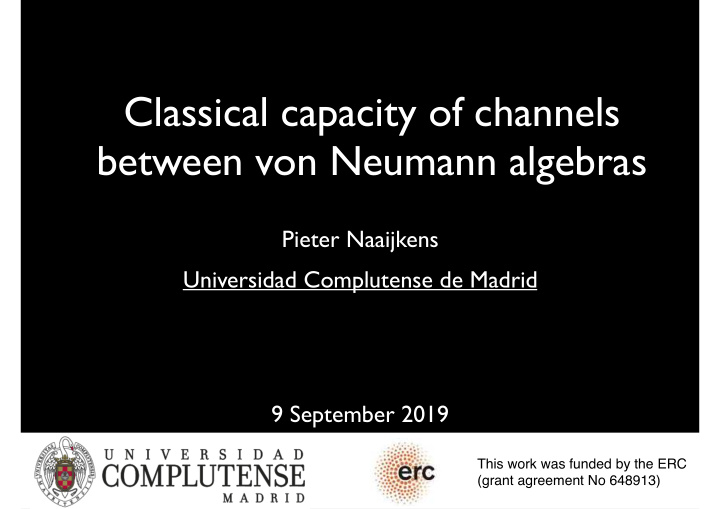



Classical capacity of channels between von Neumann algebras Pieter Naaijkens Universidad Complutense de Madrid 9 September 2019 This work was funded by the ERC (grant agreement No 648913)
Infinite quantum systems Quantum systems with infinitely many d.o.f.: Quantum field theory Systems in thermodynamic limit… e.g. quantum spin systems with topological order Can we do quantum information?
Infinite quantum systems E.g.: infinitely many spins: Stone-von Neumann uniqueness Superselection sectors Take an operator algebraic approach
Outline Von Neumann algebras Quantum information Example
Von Neumann algebras
Von Neumann algebras *-subalgebra and closed in norm It is a von Neumann algebra if closed in w.o.t.: Equivalent definition: A factor Can be classified into Type I , Type II , Type III
Normal states A state is a positive linear functional Normal if with If a factor is not of Type I, there are no normal pure states
Definition of index For irreducible inclusion index is the best constant
Araki relative entropy Let be faithful normal states: Def: Def: Umegaki:
Quantum information work mainly in the Heisenberg picture observables modelled by von Neumann algebra consider normal states on channels are normal unital CP maps Araki relative entropy
Quantum information use quantum systems to communicate main question: how much information can I transmit? will consider infinite systems here… … described by subfactors channel capacity is given by Jones index
Quantum information
Sending classical information encoding sending decoding 풴 풳 State preparation POVM measurement ∑ x ↦ ω x ↦ ℰ *( ω x ) := ω x ∘ ℰ E y ≥ 0, E y = I y ∈풴 Gives a classical channel ! 풳 → 풴 Shannon information I ( X : Y )
Distinguishing states Alice prepares a mixed state : …and sends it to Bob Can Bob recover ?
Holevo 휒 quantity In general not exactly: Generalisation of Shannon information
Holevo 휒 quantity In general not exactly: Generalisation of Shannon information
Infinite systems Suppose is an infinite factor, say Type III, and a faithful normal state where Better to compare algebras!
̂ ̂ ̂ Limited access Alice Bob identity channel ℛ ℛ restriction Eve ℛ subfactor ℛ ⊂ ℛ
Quantum wiretapping Alice Bob Eve
Theorem (Devetak, Cai/Winter/Yeung) The rate of a wiretapping channel is given by 1 χ ( { p x } , Φ ⊗ n B ( ρ x ) } ) − χ ( { p x } , Φ ⊗ n � � lim n max E ( ρ x ) } ) n →∞ { p x , ρ x }
Comparing algebras Want to compare and , with subfactor entropic disturbance
constrained Jones index and entropy channel Hiai, J. Operator Theory, ’90; J. Math. Soc. Japan, ‘91 gives an information-theoretic interpretation to the Jones index
̂ ̂ ̂ ̂ Single-letter formula 1 χ ({ p x }, { ω x }) − χ ({ p x }, { ω x | ℛ ⊗ n }) lim sup n n →∞ { p x },{ ω x } ω ∘ ℰ ⊗ n = ω ℛ ⊗ n states on with 1 ℛ ⊗ n : ℛ ⊗ n ] = lim n log[ n →∞ ℛ ⊗ n : ℛ ⊗ n ] = [ ℛ : ℛ ] n It can be shown that [ Hence we get a single letter formula !
What is missing? No coding theorem yet! no pure states analogue of typical subspaces? look at hyperfinite factors? Positive side: can find states in concrete examples subfactors are well studied
Example
k · k [ Quasi-local algebra A = A ( Λ ) Λ O A ( Λ ) = M d ( C ) x ∈ Λ
and local Hamiltonians H Λ ∈ A ( Λ ) O A ( Λ ) = M d ( C ) x ∈ Λ
ground state representation π 0 O A ( Λ ) = M d ( C ) x ∈ Λ
Toric code unique translation invariant ground state ω 0 corresponding GNS representation π 0 can identify anyonic excitations with π 0 ∘ ρ where is localised and transportable autom. ρ can recover all anyons and their properties
R A = π 0 ( A ( A )) 00 R B b R AB = π 0 ( A (( A ∪ B ) c )) 0 R AB = R A ∨ R B
Locality: R AB ⊂ b R AB but: R AB $ b R AB
A
̂ ̂ Some remarks Four states that can be distinguished ℛ AB perfectly on … … but coincide on ℛ AB Inclusion of finite dim. algebras A ↦ A ⊕ A ⊕ A ⊕ A … with “convergence” to ℛ AB ⊂ ℛ AB
Conclusions
Conclusions QI channels for op. algs. Coding theorem missing Stability of capacity?
Recommend
More recommend